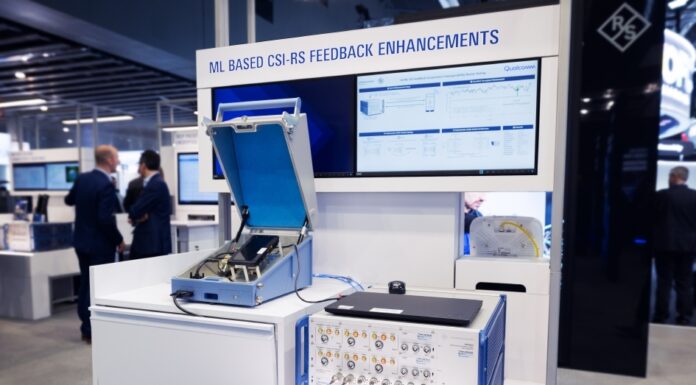Artificial intelligence is dominating discussions across the telecom landscape, as the industry grapples with how and where to apply AI to improve efficiency or performance. AI is expected to be one of the foundational concepts for 6G, which is expected to have an “AI-native” air interface.
Operators don’t want to wait for 6G in order to put AI to work. But there are incredibly complex challenges in terms of testing and validating that AI/ML-driven systems and decisions are as good or better than current methods, that they consistently perform as expected, and that they are interoperable with other AI/ML models when they need to be.
Rohde & Schwarz and Qualcomm Technologies recently demonstrated a successful industry-first implementation of “cross-node” AI/ML, with two, separately-developed models that worked together to improve downlink throughput by more than 50% in a complex 5G MIMO scenario.
Let’s break down the moving parts on this breakthrough.
Channel state information feedback, or CSI feedback, is crucial to the operation of massive MIMO antenna systems, because it enables precise beam-forming for high-performance transmission. AI/ML is expected to be able to boost system efficiency, reduce overhead and improve the user experience in 5G-Advanced and eventually, in 6G networks.
But a couple of factors make ML-based CSI feedback enhancements particularly challenging. First of all, two models—one operating on the network side and one operating on the end-user device—are needed in order for it to work. That means a different vendor produces each model, and those models have to work closely together. So cross-vendor interoperability is essential in order for the maximum benefit to be achieved. ML-based CSI feedback is the only cross-node, or “two-sided” AI pilot scenario that 3GPP has considered thus far, according to Andreas Roessler, technology manager for Rohde & Schwarz.
Roessler compared the work of the two AI/ML models to encoders and decoders in high-definition broadcasting: A complex image can be compressed into a smaller data package for transfer, and then reassembled, with the right encoders and decoders working on each side of the transmission.
So, in this case, Rohde & Schwarz developed a ML-powered decoder for its flagship CMX500 5G one-box signaling tester, which emulated the network side of the equation. Meanwhile, Qualcomm Technologies developed a device-based ML-powered encoder. Both parties used separate training approaches for their models. The two models were trained to be compatible through the use of specified reference models on which they were trained.
Once the models were trained, they were implemented together in a 5G-Advanced scenario with 8×4 MIMO via the CMX500, which transmitted that scenario to the Qualcomm test device. The smartphone model did its calculations, compressed them and sent that back to the CMX500, and the network-side model used that information to adjust beamforming in the downlink.
The result? A throughput gain of 51% compared to standard 5G: A “huge improvement,” Roessler noted.
The collaboration not only proved the feasibility of cross-vendor AI/ML implementation to improve radio performance, it showed that AI/ML-based solutions can be effectively implemented and tested across different vendors. That’s a major step to lay the groundwork for commercialization of AI-based solutions.
It also highlighted the level of partnership and collaboration needed at this stage in AI development, in order to put together a working AI solution for complex radio systems.
“This is the first time the industry did that together: Two different companies training an ML algorithm, implementing the algorithm, and it worked,” said Roessler. “That will be a starting point now for things like two-sided models, and that hopefully leads into 6G, when we have an AI-native air interface.”
To learn more about the cross-node ML-enhanced CSI feedback testing and Rohde & Schwarz’s approach to training and validating AI models, check out:

